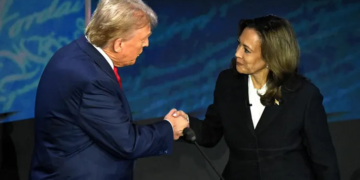Vice President Kamala Harris inched ahead of former President Donald Trump by the narrowest of margins in both polling guru Nate Silver and FiveThirtyEight’s final presidential forecasts shortly after midnight on Tuesday, although both projections showed the race for the White House remained a statistical tie on Election Day as both candidates’ poll numbers in key swing states remained deadlocked.
Silver released his final forecast after running 80,000 simulations of the race based on polling data and found that Harris had a 50.015% chance of winning compared to Trump’s 49.985%—effectively a tie—after a minor comeback of sorts by the Democrat who was down 44% to 55% at the start of November.
FiveThirtyEight also released its final forecast for the presidential race winner, giving Harris the slimmest of edges at a roughly 50% chance of winning, compared to Trump’s 49%.
Silver and FiveThirtyEight’s forecasts estimate the probability of either candidate winning, and are separate from polls, which estimate how much of the vote each candidate will get—but many national and swing state polls remain essentially tied, too.
Harris leads Trump 49%-48% with likely voters in the latest HarrisX/Forbes poll, which was taken between Wednesday and Friday and has a margin of error of one point, and she’s up 50%-48% in an Ipsos poll also out Monday.
The vice president has a larger four-point lead (51%-47%) in both a new PBS News/NPR/Marist survey and a 50,000-person poll by the Cooperative Election Study taken throughout the first 25 days of October.
Some other recent polls show a tighter race: The vice president had a 49%-47% lead in a Morning Consult survey, a 49%-46% advantage in an ABC/Ipsos poll, a 49%-47% edge in an Economist/YouGov survey and a 50%-49% advantage in a CBS/YouGov poll last week.
Meanwhile, NBC News and Emerson College polls out Sunday show the two candidates tied at 49%, and a Yahoo News/YouGov survey also produces a 47%-47% deadlock, matching up with other recent tied polls by The New York Times/Siena College, Emerson College and CNN/SSRS.
The widely followed Times/Siena poll released late last month represented a decline in support for Harris since the newspaper’s previous poll in early October showed her with a 49%-46% lead over Trump—and the paper called the results “not encouraging” for Harris as Democrats have won the popular vote in recent elections even when they’ve lost the White House.
Trump is ahead 48% to 46% in a CNBC survey of registered voters released Oct. 24 (margin of error 3.1), and he leads 47% to 45% in a Wall Street Journal registered voter poll out Oct. 23 (margin of error 2.5)—a shift in Trump’s favor since August, when Harris led 47% to 45% in a Journal survey.
Harris erased Trump’s lead over Biden since announcing her candidacy on July 21, though her edge has decreased over the past two months, peaking at 3.7 points in late August, according to FiveThirtyEight’s weighted polling average.
Big Number
1.2 points. That’s Harris’ average lead over Trump in FiveThirtyEight’s polling average. Meanwhile, RealClearPolitics’ polling average shows Harris up by 0.1, and Nate Silver has Harris up one point in his Silver Bulletin forecast.
Harris leads in Michigan, Wisconsin and Pennsylvania, and Trump leads in North Carolina, Georgia, Arizona and Nevada, according to polling averages by FiveThirtyEight. That means Harris would win the electoral college if every swing state’s polling is completely accurate—but many of the seven swing states, including crucial Pennsylvania, have margins of less than one percentage point.
Surprising Fact
A poll from NBC News released Sept. 29 found that while Harris still leads Trump among Latinos, the lead is shrinking. The NBC News/Telemundo/CNBC poll—which was conducted Sept. 16-23 among 1,000 registered Latino voters—showed 54% supported Harris compared with 40% who supported Trump and 6% who said they were unsure who they would vote for. The support for Harris is higher than it was when Biden was running against Trump, NBC said, but is still significantly lower than past leads Democratic candidates have had, including a 36-point lead in 2020 polling and 50-point lead in 2016 polling. The poll had a margin of error of 3.1 percentage points.
How Did The Debate Impact Polls?
Pre-debate surveys found Harris’ polling surge appeared to plateau, including a NPR/PBS/Marist survey of registered voters taken Sept. 3-5 that showed Harris leading Trump 49% to 48%, down from a three-point lead in August. Most post-debate surveys show the majority of respondents believe Harris won the debate, but not enough to significantly impact the horserace between the two. A New York Times/Siena poll of likely voters released Sept. 19 found the majority of voters in every demographic gave positive reviews of Harris’ Sept. 10 debate performance, with 67% overall saying she did well, compared to 40% who said the same about Trump. Harris was up 52%-46% among likely voters and 51%-47% among registered voters in an ABC News/Ipsos poll taken days following the debate on Sept. 11-13, essentially unchanged from her six-point leads with likely voters in late August and early August ABC/Ipsos surveys—even though 63% of Americans said Harris won the debate.
Source: Forbes

































